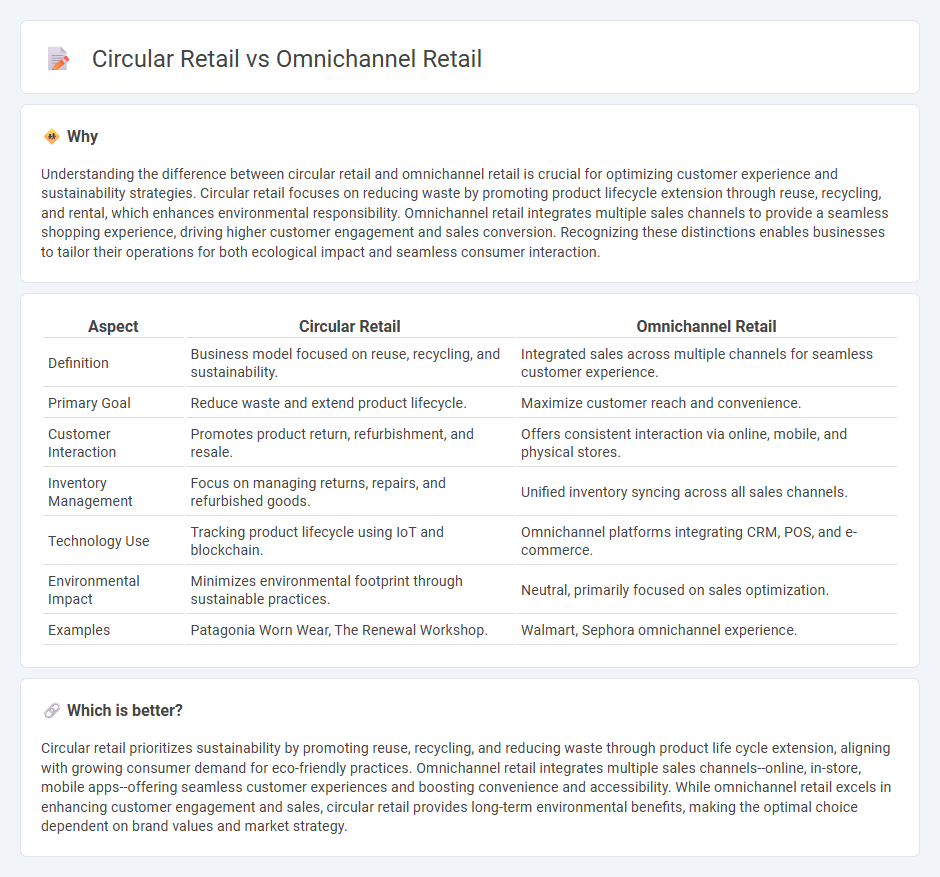
Circular retail emphasizes sustainable consumption by promoting the reuse, recycling, and refurbishment of products, reducing waste and extending product life cycles. Omnichannel retail integrates multiple shopping platforms--online, in-store, and mobile--into a seamless customer experience, enhancing convenience and engagement across touchpoints. Explore how combining circular principles with omnichannel strategies can revolutionize modern retail.
Why it is important
Understanding the difference between circular retail and omnichannel retail is crucial for optimizing customer experience and sustainability strategies. Circular retail focuses on reducing waste by promoting product lifecycle extension through reuse, recycling, and rental, which enhances environmental responsibility. Omnichannel retail integrates multiple sales channels to provide a seamless shopping experience, driving higher customer engagement and sales conversion. Recognizing these distinctions enables businesses to tailor their operations for both ecological impact and seamless consumer interaction.
Comparison Table
| Aspect | Circular Retail | Omnichannel Retail |
|---|---|---|
| Definition | Business model focused on reuse, recycling, and sustainability. | Integrated sales across multiple channels for seamless customer experience. |
| Primary Goal | Reduce waste and extend product lifecycle. | Maximize customer reach and convenience. |
| Customer Interaction | Promotes product return, refurbishment, and resale. | Offers consistent interaction via online, mobile, and physical stores. |
| Inventory Management | Focus on managing returns, repairs, and refurbished goods. | Unified inventory syncing across all sales channels. |
| Technology Use | Tracking product lifecycle using IoT and blockchain. | Omnichannel platforms integrating CRM, POS, and e-commerce. |
| Environmental Impact | Minimizes environmental footprint through sustainable practices. | Neutral, primarily focused on sales optimization. |
| Examples | Patagonia Worn Wear, The Renewal Workshop. | Walmart, Sephora omnichannel experience. |
Which is better?
Circular retail prioritizes sustainability by promoting reuse, recycling, and reducing waste through product life cycle extension, aligning with growing consumer demand for eco-friendly practices. Omnichannel retail integrates multiple sales channels--online, in-store, mobile apps--offering seamless customer experiences and boosting convenience and accessibility. While omnichannel retail excels in enhancing customer engagement and sales, circular retail provides long-term environmental benefits, making the optimal choice dependent on brand values and market strategy.
Connection
Circular retail and omnichannel retail intersect by promoting sustainable consumer practices across multiple sales channels, blending eco-friendly product lifecycle management with seamless customer experiences. Circular retail focuses on reducing waste through reuse, recycling, and refurbishment, while omnichannel retail integrates physical and digital platforms to enhance accessibility and engagement. This synergy drives customer loyalty and environmental responsibility by combining convenience with circular economy principles.
Key Terms
Omnichannel retail:
Omnichannel retail integrates multiple sales channels, including physical stores, online platforms, and mobile apps, to create a seamless customer experience and drive higher sales conversion rates. It leverages data analytics and customer insights to personalize marketing, optimize inventory management, and enhance customer engagement across touchpoints. Explore how omnichannel retail transforms shopping behaviors and boosts business growth with innovative technology solutions.
Integrated customer experience
Omnichannel retail integrates multiple sales channels such as in-store, online, and mobile apps to provide a seamless customer journey through consistent branding and synchronized inventory management. Circular retail emphasizes sustainability by incorporating product reuse, recycling, and repair services into the customer experience, promoting eco-friendly purchasing decisions. Explore how these models transform customer engagement and operational strategies in modern retail environments.
Cross-channel fulfillment
Cross-channel fulfillment in omnichannel retail integrates inventory and logistics across multiple sales channels to ensure seamless customer experiences and faster delivery times. Circular retail emphasizes cross-channel fulfillment by incorporating product returns, recycling, and refurbishment processes to minimize waste and extend product lifecycle. Explore how these approaches optimize supply chains and enhance sustainability in retail.
Source and External Links
What is Omni-Channel Retail? | Salesforce US - Omni-channel retail enables customers to interact seamlessly across multiple physical and digital channels with retained information, providing a unified and consistent shopping experience unlike multichannel retail which lacks integration.
What is Omnichannel Retailing? Basics Explained - Magestore - Omnichannel retail is a fully integrated business model where all channels are connected via centralized data management, offering shoppers a seamless experience across both physical and online platforms.
What Is Omnichannel Retail? How it Works and Examples (2024) - Omnichannel retail integrates all shopping channels into a unified customer experience, enabling shoppers to engage with brands anywhere, on any device, enhancing personalization and driving higher customer spending.
 dowidth.com
dowidth.com